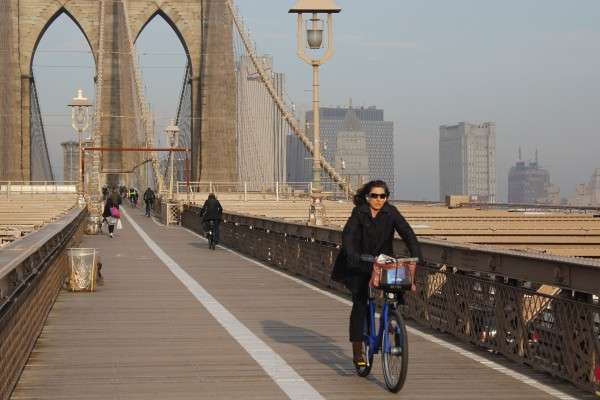Is city biking hazardous to your health?

People used to say that exercising in New York City was like smoking a pack of cigarettes. Luckily, conditions have vastly improved, according to a recent NYC Health Department report, but some areas of the city continue to have high levels of pollution. Meanwhile, many more people are biking to and from work as the network of bike paths is expanded and the Citibike program continues to grow. How much pollution are bikers exposed to, and what effects might it be having on their health?
A collaboration between WNYC and Columbia University is attempting to find some answers. Steven Chillrud, research professor at Lamont-Doherty Earth Observatory, and Darby Jack, assistant professor of Environmental Health Sciences at the Mailman School of Public Health, received a grant from the National Institute of Environmental Health Sciences to find out how much particulate matter bikers in New York City are breathing in.
Particulate matter is a complex mixture of many materials with known impacts on respiratory and cardiovascular disease. It's produced mainly by traffic, heating systems and industry. When studying particulate matter, scientists typically just look at its concentration in the air; but when people exercise, they are actually exposed to much higher levels of pollution. Jack figured that when he's at rest, he breathes in three liters of air per minute; while biking, he inhales 10 times as much. As he breathes faster and deeper, he is also taking in more particulate matter. At that rate, the amount of pollution he is exposed to begins to approach the pollution levels of Beijing and New Delhi.

When we ingest pollutants, our body clears them out at different rates depending on the type of pollution, but some of it passes into the blood stream and can circulate for up to 24 hours, explained Jack. The research is focused on how the cardiovascular system is affected both during a ride and after exposure to pollutants.
Volunteer bikers participating in the study will be outfitted with new high tech monitoring equipment that is small enough to wear comfortably and can record real-time information—an air pollution monitor, a respiration device, a blood pressure cuff, a GPS device and a special shirt that can measure heart rate variability. The equipment will have time stamping and geo-stamping capabilities. Volunteers will wear the equipment for 24 hours, including while sleeping, so that the scientists can measure their overall exposure and compare it to their commuting exposure. They will be asked to do this five times over a two-week period.
While New York City air has gotten much cleaner over the decades because buildings no longer burn trash or coal, factories have closed and cars have become much more efficient, the American Lung Association rates New York City as one of the worst in the country for fine particle pollution even now. A number of neighborhoods still have bad air quality, especially where traffic and buildings are dense, such as midtown and lower Manhattan, areas of northern Manhattan, western and southern Bronx, northern parts of Brooklyn and southern Queens.

The scientists plan to eventually use the data they gather to create a map and smart phone app that shows which roads have the most toxic air and which ones have the least. Bikers will be able to use the information to decide how, when and where to commute. The information will have implications not only for bikers, but for runners, walkers and anyone who exercises in the city. As they gain a clearer picture of the spatial variation in air pollution, the scientists believe that the combination of scientific data, political pressure and market demand will eventually drive public policy and help better design bicycle paths and infrastructure in the future.
So far, 200 people have signed up to volunteer. The five-year study can initially only handle 20 people, but over the years, it will need several hundred bikers. The researchers hope to get volunteers from different areas of the city with a variety of commuting routes.
"The question is, will societal expenditures on additional cleanups generate benefits that justify their costs? … Ultimately that's what we want to quantify," said Jack.
More information: To sign up, go to: www.columbia.edu/cu/bike/
Provided by Earth Institute, Columbia University



















